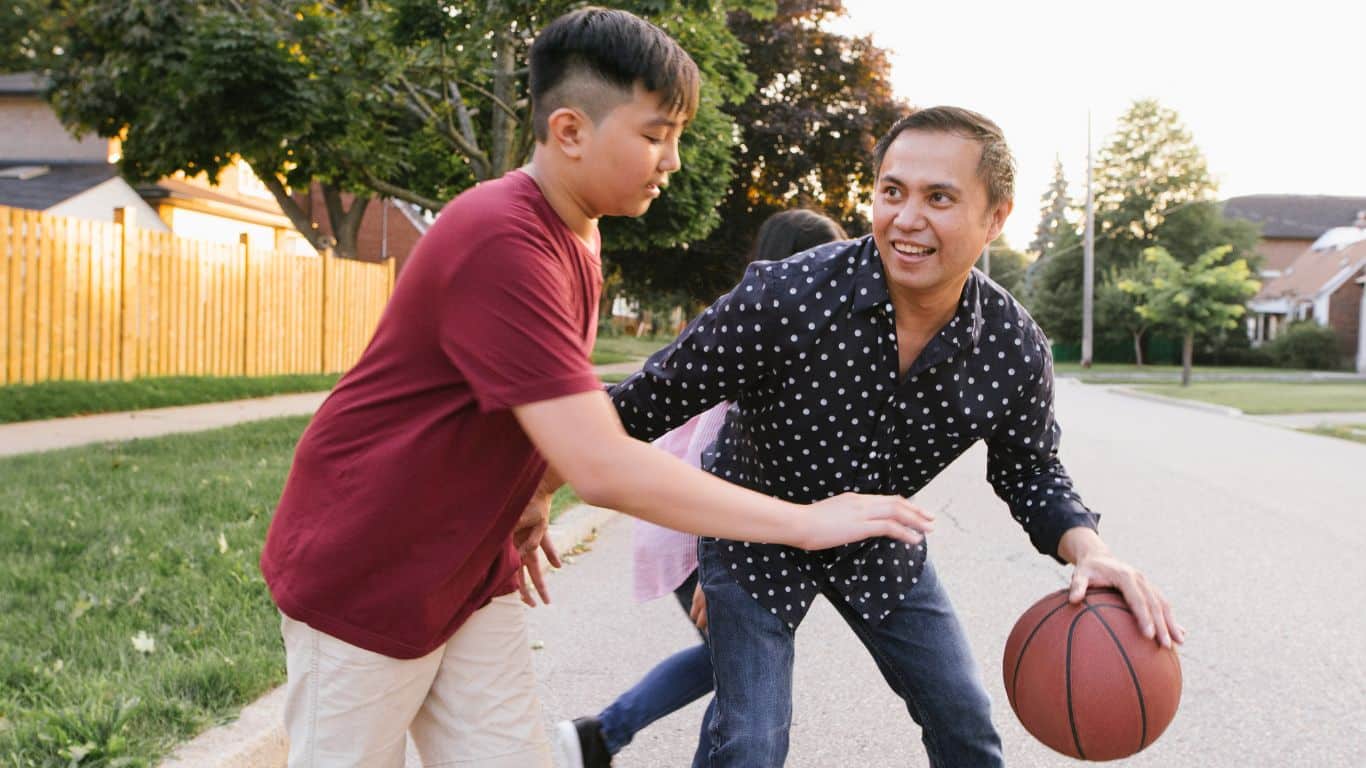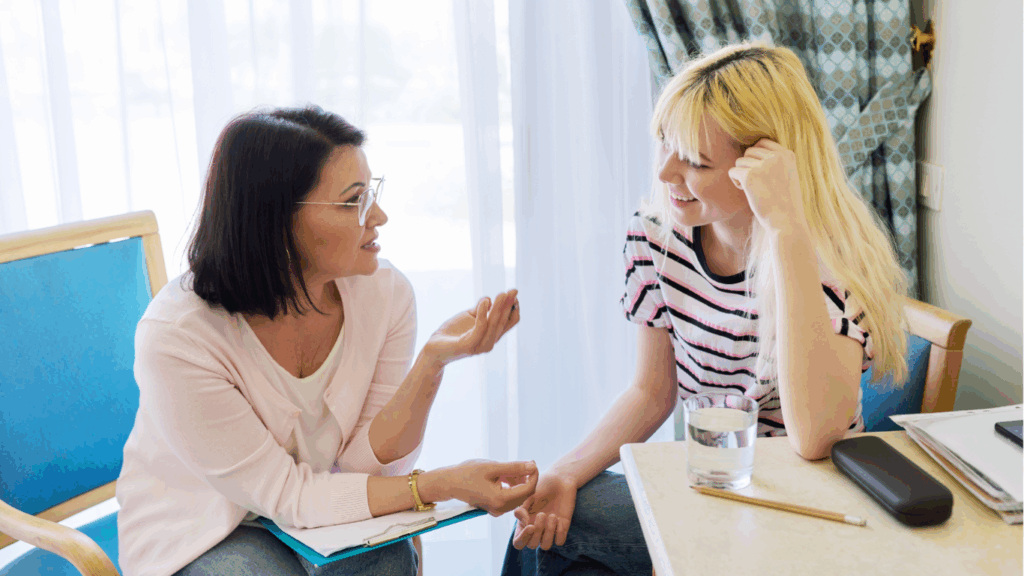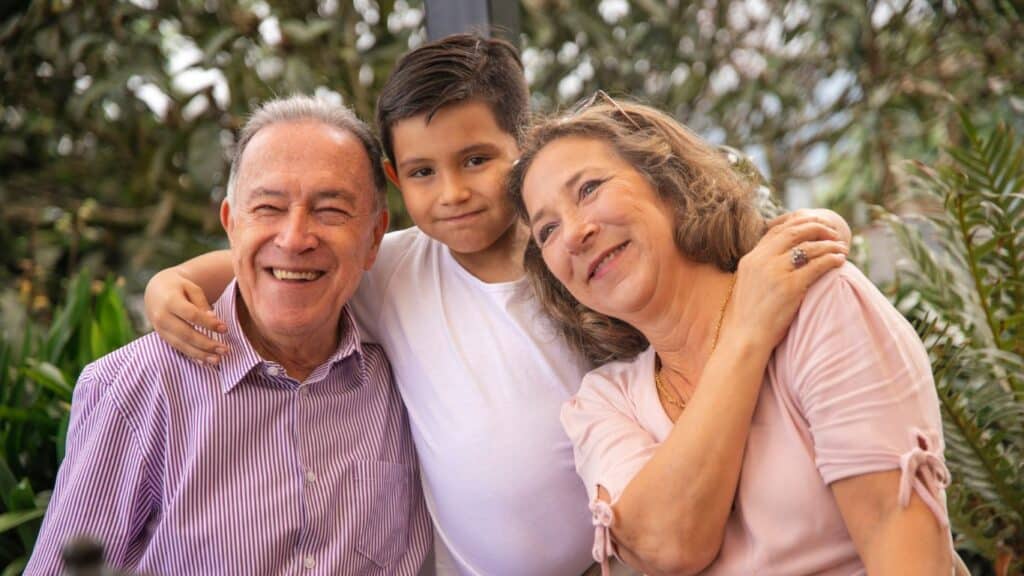Caring for a child with ADHD and a history in government care isn’t always easy. In this Q&A, adoptive parent and clinical counsellor Andrew McKenzie answers common questions and shares practical strategies for navigating ADHD and trauma.
Understanding attention deficit hyperactivity disorder (ADHD) and trauma
Q: From your experience, how do ADHD symptoms often overlap with trauma-related behaviours in children who’ve been in care?
A: One thing I’ve learned, both as a parent and through my work, is that you can’t separate a child’s developmental experiences from how they’re functioning now.
ADHD, as defined in the Diagnostic and Statistical Manual of Mental Disorders, is a set of co‑occurring symptoms. It’s considered a neurodevelopmental disorder. And sometimes, when that diagnosis is made in the context of a child who has experienced early developmental adversity, something important can get missed. Too often, the focus stays on the label and less on the developmental process that led the child to where they are today. If we don’t look at that process, we can miss a lot when it comes to supporting the child and their family.
What sets ADHD symptoms apart from trauma‑related behaviours often comes down to the developmental process that shaped the child’s current functioning.
A child with a history of early developmental stress in the context of relationships with caregivers (which is the case for most children who enter government care) may form an association in the brain between stress and caregiving. Over time, that connection can trigger the child’s stress response system. As the child grows older, the sensitized stress response can manifest as hyperactivity or poor impulse control.
For some kids, adding a stimulant to an already overactive stress response system can lead to even more hyperactivation. For others, medication helps with focus and impulse control. It depends on that child’s developmental process.
That’s a long way of saying this: in adoption and foster care, it’s even more important to look beyond an ADHD diagnosis. If a diagnosis and medication are helpful, that can be a good thing. But we also need to hold on to an understanding of the child’s developmental history. That piece is critical to supporting them.
Q: What’s the first step a caregiver can take to untangle impulsivity linked to ADHD from emotional responses rooted in past trauma?
A: In the context of adoptive and foster parents, start with what you know about the child’s developmental history.
Often, you’ll see kids respond very differently to different adults. Some children have had negative experiences with one caregiver. For example, a child might have had challenging experiences with a dad, and later, you might see hyperactive reactions or stress responses when they’re around men or male caregivers.
These reactions often show up in relationships with adults because the brain is always looking for patterns and repetition to make sense of the world. If a child experienced an unpredictable or unsafe male caregiver (maybe someone struggling with their own issues or even in a context of domestic violence), then later, something about a male teacher or caregiver might trigger an implicit memory. The child may not consciously remember, but their stress system gets activated, and the hyperactivity comes from that relational template.
If we know about these patterns, we can say, “Okay, let’s help this teacher be aware of the child’s sensitivity around male relationships. Let’s go slowly in building trust and take steps to help the child navigate that situation.”
One of the most challenging things I’ve seen is how often these behaviours are viewed as simply “the child’s problem.” Adults can take it personally, and then they don’t want to look at what they might do differently or how they might regulate themselves to respond in a calmer, more supportive way.
There are two key pieces here:
- Understand the child’s development. Their brain adapted to survive difficult circumstances. Those survival strategies may not fit new settings like school, but they served an important purpose.
- Reflect on your experience. Are you taking the behaviour personally? Are you becoming dysregulated yourself? A dysregulated adult can’t co‑regulate a dysregulated child.
A big part of my work is helping adults reflect on their own experiences (what they went through as children, as parents, as siblings) and how that shapes the way they respond now as caregivers, teachers, or foster and adoptive parents.
Those are some of the key things to think about when untangling impulsivity linked to ADHD from emotional responses rooted in trauma.
Q: Why do some adopted or foster children seem to struggle with accepting love and affection from their caregivers?
A: Dr. Bruce Perry, expert in trauma and child development, uses a term for this: intimacy barrier.
Here’s one way to understand it: Our first building block in development is attachment. It’s our ability, as infants, to create an association between relationships, reward, and regulation (like feeling joy and then being regulated). On that foundation, we develop self‑regulation. But if those pieces (relationship, reward, and regulation) aren’t woven together early on, it can be very hard for kids to learn to regulate themselves as they grow.
For example, a child might grow up with a caregiver who was sometimes loving and attuned but, at other times, overwhelmed by challenges and unable to respond as they wanted to. Over time, that inconsistency can raise the child’s overall stress level, and the brain begins to link caregiving with unpredictability.
Even really good care can feel unsafe if a child’s history has taught them something different. That’s why attunement (meeting the child where they are, not pushing ourselves on them, and moving at the pace they can handle) is so important. Even for a child from a well‑resourced, loving home, moving into another loving home would still be stressful simply because it’s different. For a child with a history of inconsistent caregiving, that stress is magnified. Sometimes, love can even feel toxic to them, which is incredibly hard for caregivers to understand.
Over the years, I’ve come to understand this better. Dr. Perry talks about responding to the intimacy barrier with the three Ps: parallel, patient, and present.
- Parallel: Don’t come in too directly. Instead of asking head‑on questions (“How was your day? How are you feeling about that visit?”), sit beside them, talk about something less direct, give them space.
- Patient: Expect them to sometimes push you away. It’s not personal.
- Present: Even if they push you away, they still need you there. They might just need more distance for now.
It takes time, patience, and attunement. Their reactions are shaped by deep developmental patterns, not a lack of desire for love.
Neurodevelopmental sequencing with Neurosequential Model of Therapeutics (NMT)
Q: How does NMT support children with ADHD and care histories?
A: The NMT is a model developed by Dr. Bruce Perry. It takes into account a child’s developmental history, experiences, and the way those experiences affected their brain development.
When we work with families, we often create what’s called a “metric” or brain map. We look at about 32 brain functions in different regions of the brain and do an in‑depth interview to see how a child is functioning in each area. From that, we develop a therapeutic sequence of engagement — always starting from the lower parts of the brain and working up, because that’s the order in which the brain develops.
The lower brain regions, like the brainstem and diencephalon, develop before birth. During the first year of life, areas controlling heart rate, blood pressure, and lung function continue to develop. Your stress response also forms then. In fact, the stress response you have today was shaped most critically during your first year of life with your caregiver.
Many children we support experienced significant challenges during this time, leaving them with highly reactive stress systems. In therapy, we focus first on regulating those lower brain regions. Once those are more regulated, we move to the limbic system (emotions) and then to the cortex (thinking).
Unlike some traditional approaches that start with talking, NMT follows the principle of “regulate, relate, and then reason.” If the lower parts of the brain are dysregulated, higher‑level reasoning won’t get through.
Q: Can you walk us through an example daily routine or practice that aligns with NMT principles for calming dysregulated systems?
A: I once worked with a student who came into class each morning spinning on his chair. His teacher wanted him to copy something from the board, but he couldn’t focus. I noticed his movement suggested his lower brain was very active — this is where stress regulation and motor coordination are centered.
I made a plan: each morning, we spent about 7–8 minutes outside bouncing a ball together. This gave him gross motor movement and a positive relational interaction. Afterward, he could focus on math for about 20 minutes, and then we’d repeat the activity.
Over time, through patterns like this, we help the brain develop new regulation pathways. As the lower parts of his brain became more regulated, he could stay engaged in higher‑level tasks for longer, and we could then set more emotional and cognitive goals.
Eye Movement Desensitization and Reprocessing (EMDR), Cognitive Behavioural Therapy (CBT), and Dialectical Behaviour Therapy (DBT) tools in practice
Q: What specific grounding or mindfulness strategies from CBT/DBT do you find most effective for hyperactive or impulsive moments?
If we set the kids aside for a moment and focus on the parents, one of the most effective things parents can gain from CBT and DBT is improved self‑regulation. Supporting parental regulation is, in my view, the most critical first step in helping a child with complex needs. When parents are regulated, they can better support their children.
DBT, developed by Marsha Linehan (who lives with borderline personality disorder), focuses strongly on emotional regulation. Helpful skills include:
- Mindfulness: grounding exercises or noticing sensory experiences.
- Distress tolerance: using distraction or redirection when emotions run high.
For kids, mindfulness can sometimes be tricky because it requires more access to higher‑level brain functions, but for parents it can be an excellent way to stay calm and present while supporting a dysregulated child.
CBT explores how thoughts, emotions, behaviours, and physical responses interact. It increasingly emphasizes using movement or physical strategies to regulate, alongside reframing thoughts.
Both CBT and DBT fit into the NMT framework: regulate first, then relate, then reason. I’ve seen this approach work with both adults and youth. When regulation comes first, then you can address thinking patterns.
Q: How can caregivers use elements of EMDR at home, such as bilateral stimulation or anchoring techniques, to support emotional regulation?
EMDR should be done with a trained professional because intense emotions can surface. With professional support, it can be very effective in processing difficult experiences.
Some therapists may include bilateral stimulation techniques for use at home as part of a broader plan to help with regulation. But deeper processing work should remain in therapy.
EMDR combines bilateral stimulation with recalling distressing memories, helping the brain regulate while revisiting them. Over time, this can reduce the emotional impact of those memories.
Structure, boundaries, and relational repair
Q: How do you balance clear routines and behavioural expectations with empathy for a system-impacted ADHD brain?
A: I’ll respond to the idea of an ADHD brain through the lens of a child impacted by early developmental adversity. Almost every child I’ve worked with who experienced early developmental adversity also had an ADHD diagnosis. These are separate conditions, but many of the symptoms overlap. When you take into account the complex early experiences many of these children have had, their needs can be even greater.
That said, balance is key: love and care must come with limits, and those limits need to be set by an attuned, regulated adult.
Adult regulation is critical, especially with children who will test you. A child might say, “I don’t feel safe with caregivers, so I’m going to test you. I’ll say no. I’ll say I don’t love you. I’ll see if you’re going to leave, or if you’ll act like other adults in my life.” They’re looking for consistency and safety.
That’s why adults need to be regulated when setting limits. Some limits are non‑negotiable, like holding a child’s hand when crossing the street, but others can be more flexible. I often ask parents, “Where can you be flexible?” Parenting children with early adversity, including those with FASD, often involves letting go of some control to share it with the child. These kids feel deeply out of control in relationships because of their past experiences. It takes time and patience to rebuild trust.
The best approach is to regulate yourself first: pause, breathe, and then respond. Say something like, “It seems like you’re really frustrated. What can help right now?” Offer choices: “Would you like to play first, or have a snack before we try again?” Giving a child options helps them feel a sense of control and creates smoother transitions.
Structure works best as a balance between clear expectations and flexibility in how those expectations are met. And remember, many children you’re parenting may have a developmental age much younger than their chronological age. Ask yourself: “How can I support them in meeting this expectation? And how can I stay regulated while doing it?”
Parenting a child who frequently says “no” can be incredibly frustrating. That’s why you also need support for yourself. Take breaks. If you have a partner, work out a system where you can tag out when you’re getting too frustrated. Don’t try to be the hero. Ask for help from partners, grandparents, or respite providers so you can recharge.
It’s challenging work, but caring for yourself helps you stay flexible and attuned.
Q: When an ADHD-related conflict escalates, what are your go-to steps for repairing the connection afterward?
A: I might sound like a broken record, but it’s worth repeating: regulate first. Make sure you are regulated before anything else.
After an escalation, remember that cortisol and adrenaline take about 30 minutes to clear. Give yourself time to calm down and return to your thinking brain. Do the same for your child — offer activities that help them regulate, like playing outside or sitting somewhere calming. When both of you are feeling more settled, that’s the time to reconnect.
A helpful approach is the “three Ps”: parallel, patient, and present. Sitting side by side feels less intense. Many parents say their best conversations happen in the car, riding together with the heated seats on. I’ve found this works well with youth and teens, and even with younger kids, because sitting side by side feels less threatening than face‑to‑face.
When you’re both calm, gently open the conversation: “Yesterday was really tough. What was going on for you? It looked like you were having a hard time.”
Often, once they feel safe and regulated, they’ll be able to open up. The key is giving time for regulation first. Better conversations and stronger connections grow from that.
The challenge is that many of us were raised in a culture of immediate correction: “You need to apologize to your sister right now!” Some kids can manage that in the moment, but many, especially those with a history of trauma, cannot. They may still be in fight‑or‑flight mode and nowhere near ready to process what happened.
Children in care often learn early on that relationships are inconsistent and ruptures aren’t repaired. Our job is to show them that repair is possible and that we’ll be there for them through it.
School and advocate collaboration
Q: What’s your advice for parents working with schools to support an ADHD child with a trauma background, especially regarding IEPs or behaviour plans?
A: I’ve worked with the school system for many decades in the Comox Valley, and I now work alongside my colleague supporting schools in the Yukon.
One thing I want to highlight is being careful with the word behaviour. Behaviour plans, depending on how they’re designed, often focus on the child’s behaviour in a way that suggests the child is simply choosing to act a certain way and could choose differently if they wanted to. That’s why I often prefer the word functioning. It shifts the focus to how the child is able to function in a given environment, rather than implying intent or choice.
When creating behaviour (or functioning) plans, be cautious with approaches that rely heavily on consequences or rewards. Many children with a sensitized stress system experience time very much in the now. Their brains are focused on survival in the moment, which makes it hard for them to connect present actions with future rewards or consequences.
That’s why plans like “Do this now and you’ll get a reward later” or “If you don’t do this now, you’ll lose a privilege later” often don’t work as intended. When a child’s brain is in survival mode, they’re not thinking ahead; they’re simply trying to feel safe right now.
The most effective plans follow the neurosequential sequence of engagement. That means starting with connection and proactive regulation. Many schools have professionals who understand these approaches (learning assistance teachers, school counsellors, or others trained in trauma‑informed methods), so it’s worth consulting with them.
These plans often look very different from traditional ones. For example, an IEP might say, “The student will enter the classroom and copy notes from the board three out of four times.” But for some children, what they actually need is to first have a snack or spend five minutes in the gym bouncing a ball to regulate, before they even step into the classroom.
In other words, we often need to give children at the start of the day what we might traditionally have offered as a reward later, because those activities are exactly what help them regulate enough to succeed in the first place.
So, when creating plans, start with regulation and connection. That sequence (regulate first, then relate, then reason) can completely change how we support children and help them thrive in school.
—
Andrew McKenzie is a BC‑registered clinical counsellor and both an adoptive and birth parent. He and his family have welcomed four children through adoption and one by birth. He has over a decade of experience working with at‑risk children in the BC public school system and draws on both his personal and professional background to support children, families, and educators.
You can learn more about Andrew at amckenziecounselling.com or by emailing him at amckenzie.bc@gmail.com.





